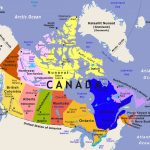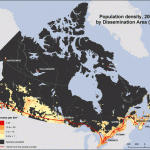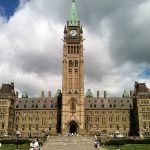
overview
Canada holds a proud international reputation for high educational standards. Canadian degree’s are internationally equivalent to degrees from the United States or Commonwealth countries. That to much less cost than any equivalent contrary Cost of living in Canada is lower than countries like Australia,England or the United States.Toronto is considered be the most expensive city in Canada, yet it is still 25% less per year then life in London,England.to Furthermore living in Toronto is less expensive then New York,Sydney,Los Angeles and Chicago.

Geography
Canada occupies the northern half of the North American continent,with a landmass of 9,093,507 km 2, making it the second- largest country in the world after Russia.Bordered by the Pacific,Atlantic and Arctic Oceans, Canada have the longest coastline of any country. To the south, Canada share an 8,893-kilometre land border—the longest in the world—with the United States. Most of the population lives within a few hundred kilometres of the southern border,in a long band that stretches between the Atlantic and Pacific oceans.Distinctive features include our vast mountain ranges: the Torngats,Appalachians and Laurentians in the east; the Rocky , Coastal and Mackenzie ranges in the west;and Mount St. Elias and the Pelly Mountains in the north. At 5,959 meters, Mount Logan in the Yukon is Canada’s tallest peak.Canada has more than two million lakes, covering about 7.6 percent of the country.In total, Canada has almost 900,000 km 2 of fresh water. Many large lakes traverse the Canada-U.S. border, but the main Canadian lakes are Huron, Superior, Great Slave, Winnipeg, Erie, Ontario and Great Bear. The St. Lawrence River (3,058 km long) is Canada’s most important river, providing a seaway for ships from the Great Lakes to the Atlantic Ocean.

Population
Canada’s population is approximately 34.5 million, with roughly 80 percent concentrated in cities and towns. The population density ratio is one of the lowest in the world at 3.7 persons per square kilometre.
As of 2012, these are the largest Canadian cities:
•Toronto (5.9 million)
•Montreal (4.0 million)
•Vancouver (2.5 million)
•Ottawa region (1.3 million)
Primarily descendants of the early French and British colonists,as well as later immigrants from eastern and southern Europe. Many religions are practiced in Canada, while almost 20 percent of Canadians claim no religious affiliation.

Language
Canada has two official languages, English and French. All federal government institutions and many businesses offer bilingual services. Chinese dialects are the third most common native language in Canada, followed by German, Italian, Punjabi and Spanish.

Political System
Canada is a constitutional monarchy and a federal state with a democratic system of government. This means Canadians recognise Queen Elizabeth II as their Head of State. Canada has clearly defined the difference between the Head of State and the Head of Government, the Prime Minister. Canada’s Parliament, situated in the capital city of Ottawa,consists of the House of Commons with 308 elected members and the Senate, where 105 members are appointed.On average, members of parliament (MPs) are elected every four years. The Prime Minister,who is usually the leader of the party with the largest number of seats in the House of Commons, is the Head of Government. The Prime Minister appoints 20 to 30 ministers who make up the Cabinet. The Cabinet develops government policy and is responsible to the House of Commons.Headed by Cabinet, the Government of Canada performs its duties through the intermediary of federal departments and agencies, boards, commissions and state-owned corporations. Each province/territory has its legislature under the leadership of a premier.A number of important aspects of daily life are the responsibility of the provincial and territorial governments, including education, health care, drivers’ licenses and labor standards.Municipal and local governments also play an important role and are normally responsible for urban or regional planning, streets and roads, sanitation (such as garbage collection),snow removal, firefighting services, ambulance and other emergency services, recreational facilities, public transportation, and some local health and social services. Most major urban centers have municipal police services.
